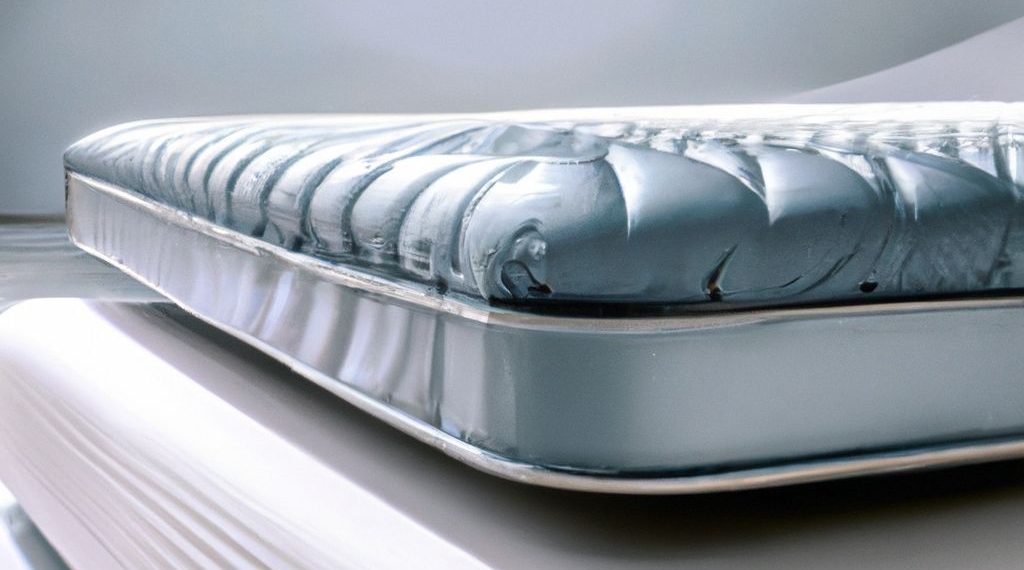Key Takeaway:
- Memory foam mattresses retain heat due to increased sinkage and lack of airflow within the material.
- The unique structure of memory foam prevents the proper circulation of air, contributing to heat retention.
- Solutions for cooling down a memory foam mattress include using cooling mattresses with temperature-regulating features, adjusting the foundation of the bed for better airflow, using cooling mattress toppers or pads made with cooling properties, replacing current sheets with moisture-wicking materials, using cooler pillows designed for airflow and heat prevention, and following additional tips for sleeping cool.
- When considering replacing a memory foam mattress, it’s important to explore options like latex, innerspring, and hybrid mattresses, as well as new memory foam mattresses with cooling gels and breathable materials. Evaluating the lifespan and supportiveness of the current memory foam mattress is also crucial.
- In conclusion, traditional memory foam mattresses have limited options for cooling down, but exploring alternative mattress types and incorporating cooling accessories can help alleviate heat retention issues.
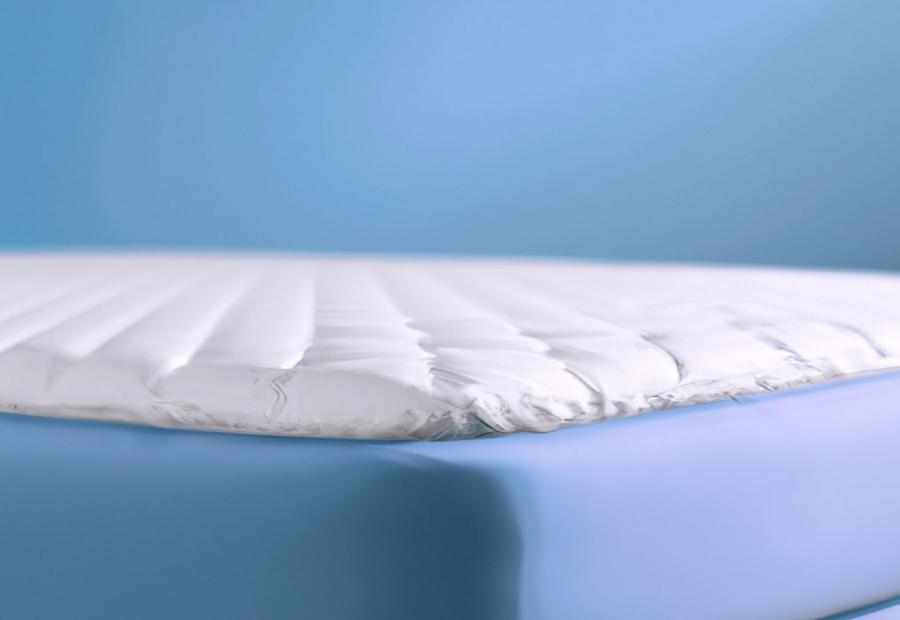
Photo Credits: Www.Mattressreviewguru.Com by Ralph Rodriguez
Memory foam mattresses are known for their comfort and support, but one common complaint that often arises is their tendency to retain heat. In this section, we’ll explore the impact of heat retention on sleep quality and overall well-being, as well as delve into the explanation of memory foam mattresses and their advantages. Discover how this issue can affect your comfort and what you can do to keep cool during your slumber.
Explanation of memory foam mattresses and their advantages
Memory foam mattresses are well-known for their special qualities. Made of memory foam, they conform to the shape of the body, offering excellent support and comfort. Plus, they evenly distribute weight, improving spinal alignment and reducing pain. Another benefit is that they limit motion transfer, making them great for couples. Yet, they can be too hot the foam traps heat, affecting sleep and well-being.
To cool down a memory foam mattress, try a cooling mattress with temperature regulating features or adjust the foundation for better airflow. Cooler sheets, mattress toppers, and pillows help too. For an even better option, consider a latex, innerspring, or hybrid mattress they usually have less heat retention. Plus, newer memory foam mattresses have cooling gels and breathable materials. Just remember: sleeping on a memory foam mattress is like cuddling with a volcano, minus the lava!
Common complaint of memory foam mattresses retaining heat
Memory foam mattresses can overheat and cause a lack of quality sleep and well-being. Sinkage and lack of airflow within the material cause heat to be trapped. To fix the problem, select cooling mattresses with temperature-regulating features. Additionally, adjust the foundation for better airflow and use cooling mattress toppers or pads. Also, switch to sheets made from moisture-wicking materials. Lastly, use cooler pillows that are designed for airflow and heat prevention.
To avoid heat retention issues, look into latex, innerspring, or hybrid mattresses. Newer memory foam mattresses may also feature cooling gels and breathable materials. Cooling down your bed is essential for a comfortable night’s sleep.
Impact of heat retention on sleep quality and overall well-being
Heat retention in memory foam mattresses can have a real effect on sleep and well-being. It disrupts the body’s natural cooling process at night, leading to discomfort and bad sleep. This can cause tossing and turning, night sweats and difficulty sleeping. This leads to decreased sleep quality, decreased alertness during the day and negative impacts on physical and mental wellbeing.
Memory foam causes heat retention – mainly due to sinking and lack of airflow. It fits closely to the body, making air not able to circulate. The structure of memory foam also restricts air flow.
There are solutions to cool down a memory foam mattress. Cooling mattresses with temperature regulating features, improving the airflow of the bed, using cooling mattress toppers or pads, getting moisture-wicking sheets, and getting pillows designed for airflow and heat prevention. Also, you can wear breathable sleepwear and keep the bedroom well-ventilated.
When thinking of replacing a memory foam mattress, there are options with better cooling properties. Latex mattresses usually sleep cooler than memory foam due to their better air flow. Innerspring mattresses and hybrid mattresses (combining memory foam and innerspring) often have cooling gels and breathable materials. Check if the mattress still provides comfort and temperature regulation.
Pro Tip: Pairing a memory foam mattress with moisture-wicking sheets can help dissipate heat and improve sleep quality.
Causes of Heat Retention in Memory Foam Mattresses
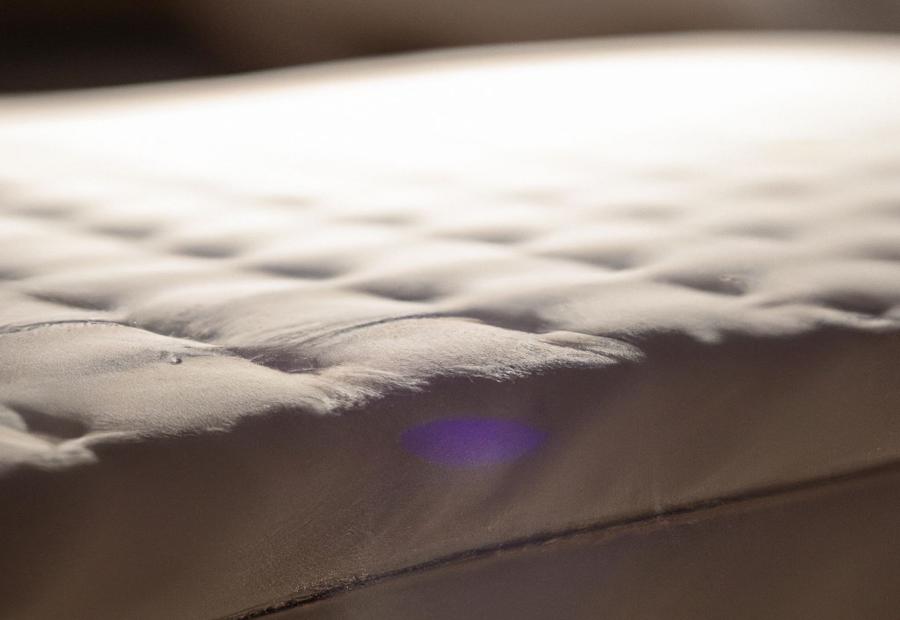
Photo Credits: Www.Mattressreviewguru.Com by Christian Lopez
Memory foam mattresses are known for their comfort, but for some, the heat retention they cause can be a real challenge. In this section, we will explore the causes of heat retention in memory foam mattresses. We’ll dive into factors such as increased sinkage and lack of airflow within the material, as well as the unique structure of memory foam that can hinder proper air circulation. By understanding these causes, you can make informed decisions on how to address this common issue and find a cooler night’s sleep.
Increased sinkage and lack of airflow within the material
Memory foam mattresses can sometimes experience sinkage and a lack of air circulation, leading to heat retention. The body’s weight compresses the foam, creating a contouring effect and blocking the escape of heat. This can cause an excessively warm sleep environment and disrupt overall wellbeing.
The lack of air circulation is due to the dense structure of memory foam, forming a barrier around the body and trapping heat. Plus, memory foam itself has insulating properties that contribute to the heat-retaining issue.
In response, mattress manufacturers are now offering cooling features in some memory foam mattresses. Cooling gels and breathable fabrics promote airflow and dissipate heat. Additionally, individuals can adjust the bed’s foundation for better airflow, use cooling mattress toppers or pads, and sheets made from moisture-wicking materials. Cooler pillows enhance comfort and reduce heat retention.
Though these solutions may not completely eliminate the heat from memory foam, they can improve sleeping conditions and aid in temperature regulation. To prevent overheating while sleeping, it is important to address the lack of airflow in memory foam.
Unique structure of memory foam preventing proper circulation of air
Memory foam mattresses have a unique structure. This blocks air circulation, causing heat to stay trapped. The mattress sinks in and takes up less space for air to flow. Memory foam itself also stops air from moving. Due to this, manufacturers have devised solutions to cool down memory foam mattresses.
Effective options to cool down memory foam mattresses include:
- Temperature-regulating mattresses
- Adjusting the foundation of the bed
- Cooling mattress toppers
- Sheets made from moisture-wicking materials
- Cooler pillows also help airflow and heat prevention
Don’t let your mattress turn you into a hot mess – cool it down with these solutions!
Solutions to Cool Down a Memory Foam Mattress
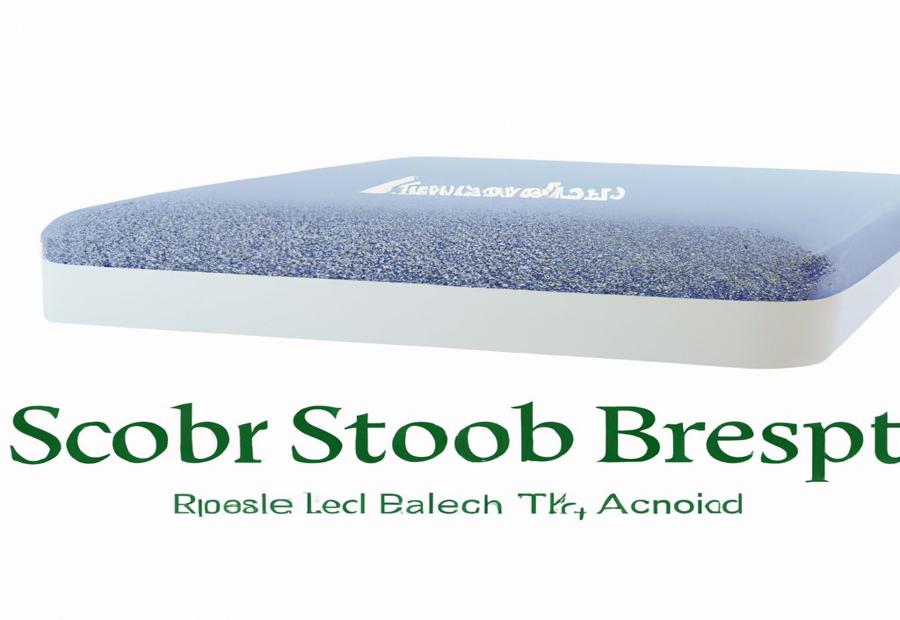
Photo Credits: Www.Mattressreviewguru.Com by John Garcia
Looking to cool down your memory foam mattress? Look no further. In this section, we’ll explore a range of solutions that can help alleviate the heat retention often associated with memory foam mattresses. From cooling mattresses with temperature-regulating features to using moisture-wicking sheets and airflow-enhancing bed foundations, we’ve got you covered with practical tips and advice. Say goodbye to those restless, hot nights and say hello to a cooler, more comfortable sleep.
Cooling mattresses with temperature-regulating features
Cooling mattresses have temperature-regulating features. Advanced tech helps dissipate heat. Breathable materials promote airflow and ventilation, for a cool sleep surface. Cooling gels or gel-infused foams absorb and disperse body heat. Moisture-wicking features prevent sweat build-up. Plus, these mattresses have customizable temperature control.
These features fight the heat retention of memory foam mattresses. You get cooling tech and contouring and pressure-relieving properties. You’ll get relief from heat and enhanced support and pressure relief. No more feeling like camping in the Sahara!
Adjusting the foundation of the bed to allow for better airflow
Memory foam mattresses are renowned for their contouring capabilities and personalised support. But, users commonly grumble that they retain heat. This can adversely impact sleep quality and overall wellbeing; too much heat disrupts sleep patterns and leads to discomfort. A solution to cool down a memory foam mattress is amending the bed’s foundation to promote air circulation.
- Elevating the mattress: Raise it off the ground with bed risers or a slatted foundation.
- Slatted foundations: Gaps between the slats allow air to flow freely, preventing heat build-up.
- Removing excess bedding: Too many layers trap heat and reduce breathability. Strip away thick pads, comforters, or extra blankets.
- Maintaining cleanliness: Clean underneath the bed to ensure no blockages obstruct airflow.
- Using breathable materials: Opt for bedding accessories like cotton or linen that won’t impede air circulation.
Also, consider other factors that may contribute to heat retention. Polyester sheets or synthetic blends, for instance, trap heat. Switch to cooling sheets made from moisture-wicking fabrics. Furthermore, add cooling mattress toppers or pads with cooling properties for extra temperature regulation and to prevent heat absorption by the memory foam mattress.
Using cooling mattress toppers or pads with cooling properties
Memory foam mattresses are renowned for their comfort and support, yet there’s one common gripe: heat retention. This can cause discomfort during sleep, and harm well-being.
To stop the heat buildup from memory foam mattresses, cooling mattress toppers or pads with cooling properties can help.
These accessories are designed to regulate temperature and prevent heat buildup. They create a barrier between the body and the foam, allowing for better airflow. Plus, they often incorporate cooling technologies such as gel-infused foams or phase-change materials. These materials absorb excess heat from the body and release it back when needed. And they’re typically made from breathable fabrics that wick away moisture and promote airflow.
Using these cooling accessories can allow individuals to enjoy the benefits of a memory foam mattress while remaining cool throughout the night. To further reduce heat retention, adjust the foundation of the bed for better airflow, invest in a memory foam mattress with temperature-regulating features, replace current sheets with cooling ones made from moisture-wicking materials, and use pillows specifically designed for airflow and heat prevention.
These solutions can help to cool down a memory foam mattress. It’s all about finding what works best for your needs and preferences. Sweating in bed should be reserved for nightmares, not reality!
Replacing current sheets with cooling ones made from moisture-wicking materials
Memory foam mattresses are known for providing optimal comfort and support. Yet, one common complaint is their tendency to retain heat. This is due to increased sinkage and lack of airflow in the material.
A way to address this is to replace sheets with plush gel memory foam ones made from moisture-wicking materials. These sheets pull moisture away from the body, which promotes evaporation and reduces heat buildup.
There are other options to cool down a memory foam mattress. Mattresses with temperature-regulating features can provide a cool surface. Adjusting the foundation of the bed can also help airflow. Cooling mattress toppers or pads offer an extra layer of coolness.
Replacing current sheets with cooling ones is a practical solution. Investing in these specialized sheets can improve sleep quality. Don’t miss out on enhancing comfort and well-being while sleeping. Take this simple step towards better sleep hygiene!
Using cooler pillows designed for airflow and heat prevention
Pillows specifically designed for airflow and heat prevention can help you sleep cooler. They feature construction that lets air flow freely, eliminating heat buildup. Plus, some have breathable materials or perforations to boost ventilation. Also, cooling gel technology may be included for added relief from heat.
These pillows not only regulate temperature, but offer superior support for your head and neck. This helps alignment during sleep and promotes a better quality of sleep.
When selecting a cooler pillow, consider your sleeping position, comfort preferences, and any special neck or spinal support needs. Choose one that works for you and enhances your sleep!
Additional tips for sleeping cool
This article looks at factors causing heat retention in memory foam mattresses. It offers solutions, too! One heading is “Additional tips for sleeping cool”. This section has advice for getting a comfortable, cool sleep. Here are these tips:
- Choose breathable bedding materials: Pick sheets made of fabrics like bamboo or cotton. These draw away moisture and help air circulate, keeping you cooler.
- Utilize a cooling pillow: Look for pillows designed to let air flow and reduce heat. Memory foam pillows with cooling powers or ones made from breathable materials are great choices.
- Create a cool sleep environment: Pay attention to your bedroom’s temperature. Keep the room ventilated by opening windows or using fans. Consider a dehumidifier to lower humidity levels.
These tips address heat retention in memory foam mattresses. By selecting the right bedding, using cooling pillows, and creating a cool sleep environment, people can have a better sleep experience.
Is it time to give your memory foam mattress the cold shoulder?
Considerations for Replacing a Memory Foam Mattress
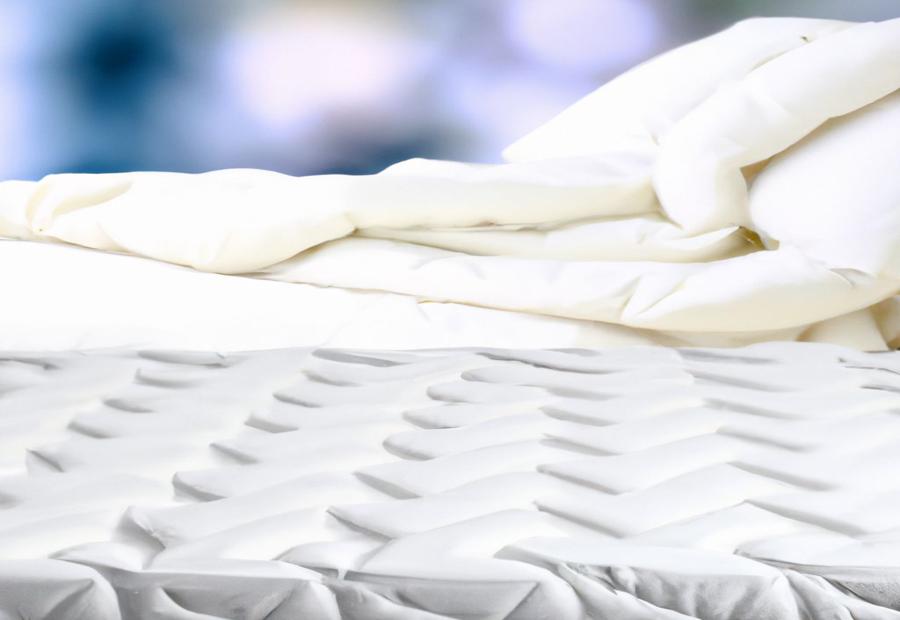
Photo Credits: Www.Mattressreviewguru.Com by Dylan Hall
When it comes to considering a replacement for your memory foam mattress, there are a few key factors to keep in mind. From exploring alternative options like latex, innerspring, and hybrid mattresses to exploring new memory foam mattresses with cooling gels and breathable materials, there are choices to suit different needs. Additionally, evaluating the lifespan and supportiveness of your current memory foam mattress is crucial. Let’s dive into the considerations for replacing your memory foam mattress and find the perfect choice for a cooler and more comfortable sleep.
Potential options: latex, innerspring, and hybrid mattresses
Memory foam mattresses are renowned for comfort and pressure relief. But, they have one common issue – heat retention. This can drastically weaken sleep quality and overall well-being. The causes of this heat retention are extra sinkage, no airflow in the material, and the unique structure of memory foam that stops air from circulating.
To cool down a memory foam mattress, there are options:
- Pick a cooling mattress with temperature-regulating properties.
- Raise the mattress or use a slatted bed frame to promote air circulation and reduce heat.
- Use cooling mattress toppers or pads with cooling properties.
- Replace sheets with cooling ones made from moisture-wicking materials. These sheets pull moisture away and promote evaporation.
- Use cooler pillows for airflow and heat prevention.
When replacing a memory foam mattress, consider latex mattresses which sleep cooler due to natural materials. Innerspring mattresses provide excellent airflow due to their coil construction. Hybrid mattresses combine coils and memory foam layers, offering both support and breathability.
For a cool sleep experience, try new memory foam mattresses with cooling gels and breathable materials.
New memory foam mattresses with cooling gels and breathable materials
Memory foam mattresses with cooling gels and breathable materials provide an inventive answer to heat buildup in regular memory foam mattresses. These mattresses are designed to manage temperature and give a cooler sleep atmosphere, improving comfort and sleep quality. Cooling gels and breathable materials tackle the issues of increased sinkage and lack of airflow that cause heat retention.
- The cooling gels in these new memory foam mattresses dissipate body heat, which results in a cooler sleeping surface.
- The breathable materials in these mattresses promote superior air circulation, preventing too much heat from building up.
- Because of their innovative temperature-regulating features, these mattresses provide a restful sleep experience by keeping the sleeper cool throughout the night.
These improved designs and technologies make the new memory foam mattresses with cooling gels and breathable materials the more desirable option for those in search of a cooler and more comfortable sleep surface. By addressing heat retention, these mattresses lead to improved sleep quality and overall contentment.
Evaluating the lifespan and supportiveness of the current memory foam mattress
Comprehending the lifespan and supportiveness of a present memory foam mattress is essential for attaining ideal sleep excellence and all-round wellbeing. By inspecting these elements, people can make knowledgeable choices about whether it’s time to switch their mattress and investigate other alternatives that may better fulfill their requirements based on factors like toughness, backing, comfort, and personal conditions.
Evaluating whether the current memory foam mattress still gives sufficient support for one’s sleep needs is a must, ensuring suitable spinal alignment and pressure relief.
Moreover, it is critical to consider how comfortable the current memory foam mattress remains over time. Although memory foam mattresses initially offer a plush and luxurious feel, they can soften or form body impressions with extended use.
Examining one’s comfort level and reflecting upon any changes in sleep preferences can aid in deciding if it is time for a replacement.
Lastly, it’s necessary to take into account any drastic alterations in personal circumstances that may necessitate an inspection of the current memory foam mattress’s lifespan and supportiveness. Factors such as weight gain or loss, health conditions that call for particular backing or pressure relief considerations (e.g., back pain or joint issues), or changes in sleep position preferences should be taken into consideration when deciding whether it is time for a new mattress.
Conclusion: Limited options for cooling down traditional memory foam mattresses

Photo Credits: Www.Mattressreviewguru.Com by James Brown
Traditional memory foam mattresses can become hot and there’s limited ways to cool them. Their dense structure traps heat and blocks airflow. To fix this, a few measures can be taken.
- Specialized mattress toppers with breathable materials such as gel-infused or open-cell foam can help regulate temperature.
- Moisture-wicking covers made of bamboo or cotton can absorb and evaporate sweat.
- Cooling mattress pads or blankets with cooling gel can help as well.
- Using an adjustable bed base can improve airflow.
- Keeping the bedroom cool and using climate control devices like fans or AC can help.
- Breathable sheets and pillowcases made of cotton or other moisture-wicking fabrics will help airflow around the body.
- Looking into the cooling properties of different mattress options before purchasing is crucial. Doing so can help create a more comfortable sleep environment.
Some Facts About Why My Memory Foam Mattress is So Hot:
- ✅ Memory foam mattresses retain heat due to increased sinkage and lack of airflow within the material. (Source: Team Research)
- ✅ The unique structure of memory foam prevents proper circulation of air, leading to heat accumulation during sleep. (Source: Team Research)
- ✅ Cooling mattresses with temperature-regulating features have been created to address the heat retention issue in memory foam mattresses. (Source: Team Research)
- ✅ Adjusting the foundation of your bed to allow for better airflow can help cool down a memory foam mattress. (Source: Team Research)
- ✅ Using a cooling mattress topper or pad made of materials like gel foam, down alternative, or natural cotton can provide added comfort and temperature regulation for a memory foam mattress. (Source: Team Research)
FAQs about Why Is My Memory Foam Mattress So Hot
Why does my memory foam mattress retain heat?
Memory foam mattresses retain heat due to increased sinkage and lack of airflow within the material. The unique structure of memory foam prevents proper circulation of air, leading to heat accumulation and discomfort.
How can I cool down my memory foam mattress without buying a new one?
There are several ways to cool down a memory foam mattress without investing in a new one. You can adjust the foundation of your bed to allow for better airflow by replacing a solid plywood base with wooden boards that provide open space. Using a cooling mattress topper made of gel foam, down alternative, or natural cotton can also help regulate temperature. Additionally, switching to cooling sheets made of materials like Egyptian cotton or bamboo can enhance cooling.
What are cooling mattress toppers?
Cooling mattress toppers are bedding accessories designed to regulate temperature and provide added comfort. They come in various materials such as gel foam, down alternative, or natural cotton, which have cooling properties. By placing a cooling topper on your memory foam mattress, you can create a cooler sleep environment.
Which bedding materials are recommended for cooling a memory foam mattress?
To cool down a memory foam mattress, it is recommended to use bedding materials made of Egyptian cotton, bamboo, gel foam, or natural cotton. These materials have properties that wick away moisture and heat from your body, creating a cooler sleep surface.
How can I make my memory foam mattress cooler during the night?
To make your memory foam mattress cooler during the night, you can lower the thermostat, open windows for cross ventilation, wear breathable pajamas, and turn off lights to reduce heat from lighting sources. Additionally, using a cooler pillow and replacing your current sheets with cooling ones made of materials like Egyptian cotton or bamboo can help regulate your body temperature while you sleep.
Are there alternative mattress options that sleep cooler than memory foam?
Yes, there are alternative mattress options that naturally sleep cooler than memory foam. Latex, innerspring, and hybrid mattresses have increased airflow, making them cooler. However, some memory foam mattresses now include cooling gels and breathable materials to address the heat retention issue. If your memory foam mattress is no longer supportive enough, it may be time to consider a new mattress.

